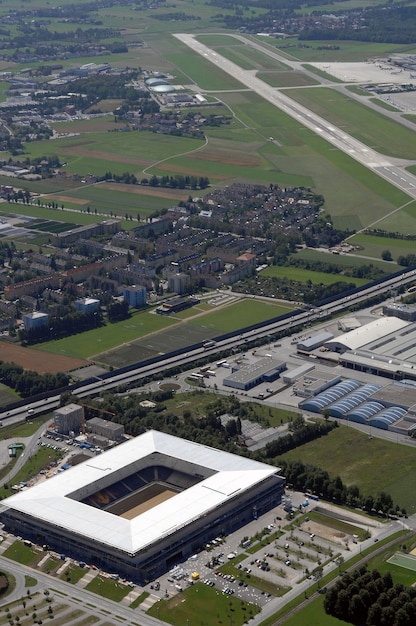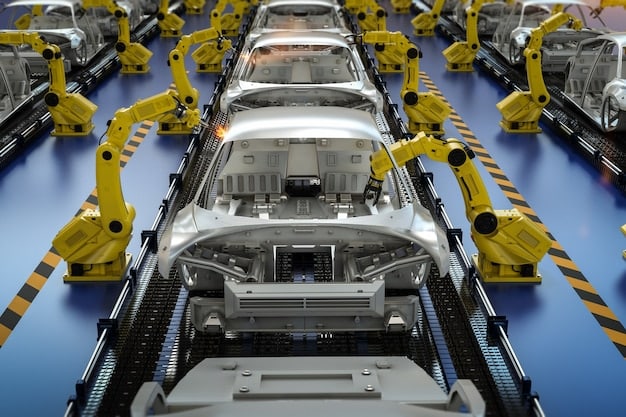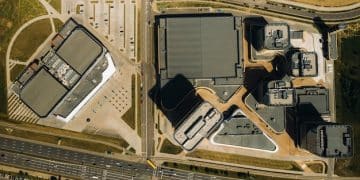US Electric Vehicle Boom: 3 New Factories & 10,000 Jobs by 2026

The **Electric Vehicle Manufacturing Boom: Three New Electric Vehicle Factories to Open in the US by Early 2026, Creating 10,000 Jobs** signifies a major shift in the automotive industry, boosting local economies and promoting sustainable transportation.
The automotive landscape in the United States is undergoing a dramatic transformation with an **Electric Vehicle Manufacturing Boom: Three New Electric Vehicle Factories to Open in the US by Early 2026, Creating 10,000 Jobs**, promising a greener future and significant economic growth.
Electric Vehicle Revolution: A Manufacturing Surge in the US
The United States is witnessing an unprecedented surge in electric vehicle (EV) manufacturing, fueled by growing consumer demand, government incentives, and technological advancements. This **electric vehicle revolution** is not just about replacing gasoline cars with electric alternatives; it’s about creating a new industrial ecosystem that drives innovation, job creation, and economic prosperity.
Several factors are contributing to this manufacturing boom. Firstly, favorable government policies, such as tax credits for EV purchases and investments in charging infrastructure, are making electric vehicles more attractive to consumers. Secondly, advancements in battery technology are improving the range and performance of EVs, addressing a key concern for potential buyers. Finally, major automakers are committing billions of dollars to electrify their fleets, signaling a long-term shift towards electric mobility.

Key Drivers of the EV Manufacturing Boom
The rise of electric vehicle manufacturing in the US is supported by several key factors, which are interlinked. These factors create a powerful combination that propels the growth and expansion of the EV industry.
- Government Incentives: Federal and state governments are offering significant incentives, including tax credits, grants, and loan programs, to encourage both consumers and manufacturers to adopt and produce electric vehicles.
- Technological Advancements: Continuous improvements in battery technology, charging infrastructure, and electric powertrain efficiency are making EVs more competitive with traditional gasoline vehicles.
- Consumer Demand: Growing awareness of environmental issues, coupled with the desire for fuel-efficient and technologically advanced vehicles, is driving increasing consumer demand for EVs.
The EV manufacturing push in the US is also a response to the global shift towards sustainable transportation. Countries around the world are setting ambitious goals for reducing greenhouse gas emissions, and electric vehicles are playing a crucial role in achieving these goals.
In conclusion, the electric vehicle revolution in the US is not just a trend; it’s a fundamental shift in the automotive industry. The combination of government support, technological advancements, and growing consumer demand is creating a strong foundation for long-term growth and sustainability.
New Electric Vehicle Factories: Powering the Future of Transportation
The announcement of three new electric vehicle factories in the US by early 2026 marks a significant milestone in the country’s transition to electric mobility. These factories represent a substantial investment in the future of transportation, promising to create thousands of jobs and boost local economies.
These new facilities are strategically located to take advantage of existing automotive supply chains, skilled labor pools, and access to key transportation infrastructure. This allows manufacturers to streamline their operations, reduce costs, and accelerate the production of electric vehicles.
Factory Locations and Their Strategic Importance
Choosing the right location for an EV factory is critical for its success. Locations are chosen based on access to resources, infrastructure, and skilled labor. Here’s why location matters:
- Proximity to Suppliers: Locating factories near existing automotive suppliers reduces transportation costs and improves supply chain efficiency.
- Skilled Labor Pool: Access to a skilled workforce is essential for operating advanced manufacturing facilities and ensuring high-quality production.
- Infrastructure: Good transportation infrastructure, including highways, railways, and ports, is necessary for moving raw materials and finished vehicles efficiently.
The new factories are expected to produce a range of electric vehicles, from passenger cars and SUVs to commercial trucks and buses. This diverse product portfolio will help meet the growing demand for electric vehicles across different market segments. The factories are incorporating advanced manufacturing technologies, such as robotics, automation, and artificial intelligence, to improve efficiency, reduce costs, and enhance product quality.
In summary, the establishment of new electric vehicle factories in the US is a major step forward in the country’s transition to electric mobility. These factories will not only create thousands of jobs but also contribute to a cleaner, more sustainable transportation system.
Creating 10,000 Jobs: Economic Boost from EV Manufacturing
The arrival of these new electric vehicle factories is set to generate over 10,000 jobs, offering a major economic boost to the local communities where they are situated. These jobs span a wide range of roles, from manufacturing and engineering to management and administration, providing opportunities for people with diverse skills and backgrounds.
The creation of these jobs is particularly significant in regions that have been affected by the decline of traditional manufacturing industries. The electric vehicle manufacturing boom can help revitalize these communities, providing new sources of employment and economic growth.
The Ripple Effect of Job Creation
The creation of 10,000 jobs in the EV sector is just the beginning. Consider all the additional benefits that these jobs can provide to local economies. It’s a multifaceted boost that ensures economic growth and prosperity.
- Increased Consumer Spending: New jobs lead to increased consumer spending, which benefits local businesses and stimulates economic activity.
- Tax Revenue: New factories and employees generate significant tax revenue for local governments, which can be used to fund public services and infrastructure improvements.
- Skills Development: The EV industry provides opportunities for workers to develop new skills and advance their careers, improving their long-term economic prospects.
Local educational institutions and training programs are also playing a vital role in preparing workers for the new jobs in the electric vehicle industry. These programs provide training in areas such as robotics, automation, and electric vehicle maintenance, ensuring that workers have the skills needed to succeed in the industry.
Overall, the creation of 10,000 jobs through the electric vehicle manufacturing boom represents a significant economic opportunity for the United States. These jobs will not only provide employment for thousands of people but also contribute to the growth and diversification of the American economy.

Government Support and Incentives: Fueling the EV Industry
Government support and incentives play a crucial role in fueling the electric vehicle industry. Federal, state, and local governments are implementing a range of policies to encourage the adoption and production of electric vehicles, including tax credits, grants, loan programs, and regulatory measures.
These policies help reduce the cost of electric vehicles for consumers, making them more competitive with traditional gasoline vehicles. They also provide financial support for manufacturers to invest in new factories, technologies, and workforce training programs.
The Impact of Government Policies on EV Adoption
Government policies are the backbone of EV adoption, driving both consumer interest and manufacturer investment. The collaboration ensures a stable and thriving market for electric vehicles.
- Tax Credits: Federal and state tax credits reduce the upfront cost of electric vehicles, making them more affordable for consumers.
- Grants and Loans: Government grants and loan programs provide financial support for manufacturers to invest in new factories and technologies.
- Regulations: Government regulations, such as emissions standards and fuel efficiency requirements, encourage automakers to produce more electric vehicles.
Many states are also implementing their own incentives for electric vehicles, such as rebates, tax exemptions, and access to high-occupancy vehicle (HOV) lanes. These incentives further reduce the cost of electric vehicles and make them more attractive to consumers.
In short, government support and incentives are essential for accelerating the adoption of electric vehicles and building a robust EV manufacturing industry in the United States. These policies help create a level playing field for electric vehicles, reduce greenhouse gas emissions, and promote economic growth.
Challenges and Opportunities in the EV Manufacturing Sector
While the electric vehicle manufacturing boom presents many opportunities, it also poses some challenges. These challenges include supply chain constraints, workforce shortages, and the need for continued innovation to improve the performance and affordability of electric vehicles.
However, the electric vehicle industry is actively addressing these challenges through various strategies, such as diversifying supply chains, investing in workforce training programs, and collaborating on research and development initiatives.
Overcoming Challenges in EV Manufacturing
The EV manufacturing sector faces unique difficulties, but strategic planning and innovation can help overcome them. Here are the primary barriers and the measures being taken to mitigate them:
- Supply Chain Constraints: Shortages of critical materials, such as lithium and cobalt, can disrupt the production of batteries and electric vehicles.
- Workforce Shortages: The electric vehicle industry requires a skilled workforce, but there is currently a shortage of qualified workers.
- Technology Advancements: Continuous innovation is needed to improve the range, performance, and affordability of electric vehicles.
Despite these challenges, the electric vehicle industry is well-positioned for long-term growth. The combination of government support, technological advancements, and growing consumer demand is creating a strong foundation for the industry’s future.
In conclusion, while the electric vehicle manufacturing sector faces some challenges, the opportunities for growth and innovation are immense. By addressing these challenges proactively, the industry can continue to expand, create jobs, and contribute to a more sustainable future.
Looking Ahead: The Future of Electric Vehicle Manufacturing in the US
The future of electric vehicle manufacturing in the United States looks bright. As consumer demand for electric vehicles continues to grow, and as technology continues to improve, the electric vehicle industry is poised for further expansion and innovation.
The establishment of new factories and the growth of the existing EV manufacturing base will create even more jobs, boost local economies, and reduce greenhouse gas emissions, contributing to the sustainability.
Predictions for the EV Industry in the Coming Years
The electric vehicle industry is constantly evolving, so it is crucial to anticipate future trends and adapt accordingly. These predictions will guide investment and growth in the sector.
- Increased Production Capacity: The US will see a significant increase in electric vehicle production capacity, as new factories come online and existing factories expand.
- Technological Breakthroughs: Advancements in battery technology, charging infrastructure, and electric powertrain efficiency will improve the performance and affordability of electric vehicles.
- Market Diversification: The electric vehicle market will diversify, with new models and segments emerging to meet the needs of different consumers.
The electric vehicle manufacturing boom is also expected to spur innovation in related industries, such as battery manufacturing, charging infrastructure, and autonomous driving technology. This innovation will further enhance the performance, convenience, and safety of electric vehicles.
In summary, the future of electric vehicle manufacturing in the US is promising, with significant opportunities for growth, innovation, and job creation. As the industry continues to evolve, it will play an even greater role in shaping the future of transportation and promoting a more sustainable society.
| Key Point | Brief Description |
|---|---|
| ⚡ EV Factory Boom | Three new EV factories set to open in the US by early 2026. |
| 💼 Job Creation | These factories will create approximately 10,000 new jobs. |
| 🌱 Sustainability | EV manufacturing contributes to a greener and more sustainable transportation system. |
| 📈 Economic Growth | The EV boom offers significant economic benefits to local communities. |
Frequently Asked Questions
▼
The boom is due to a combination of factors, including increased consumer demand, government incentives, and significant advancements in battery technology.
▼
The specific locations vary, but they are strategically positioned to leverage existing automotive supply chains, skilled labor, and key transportation infrastructure.
▼
The jobs will span a wide range of roles, including manufacturing, engineering, management, and administration, providing diverse opportunities.
▼
Government support comes in the form of tax credits, grants, and loan programs, which help make EVs more affordable and support manufacturing investments.
▼
The sector faces challenges such as supply chain constraints and workforce shortages, but it’s actively addressing these through various strategies and innovations.
Conclusion
The **Electric Vehicle Manufacturing Boom: Three New Electric Vehicle Factories to Open in the US by Early 2026, Creating 10,000 Jobs** signifies a pivotal moment for the automotive industry in the United States. This surge not only reflects a commitment to sustainable transportation but also promises substantial economic benefits through job creation and regional revitalization, paving the way for a greener and more prosperous future.





